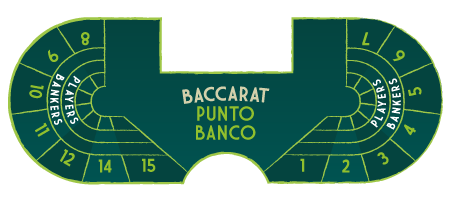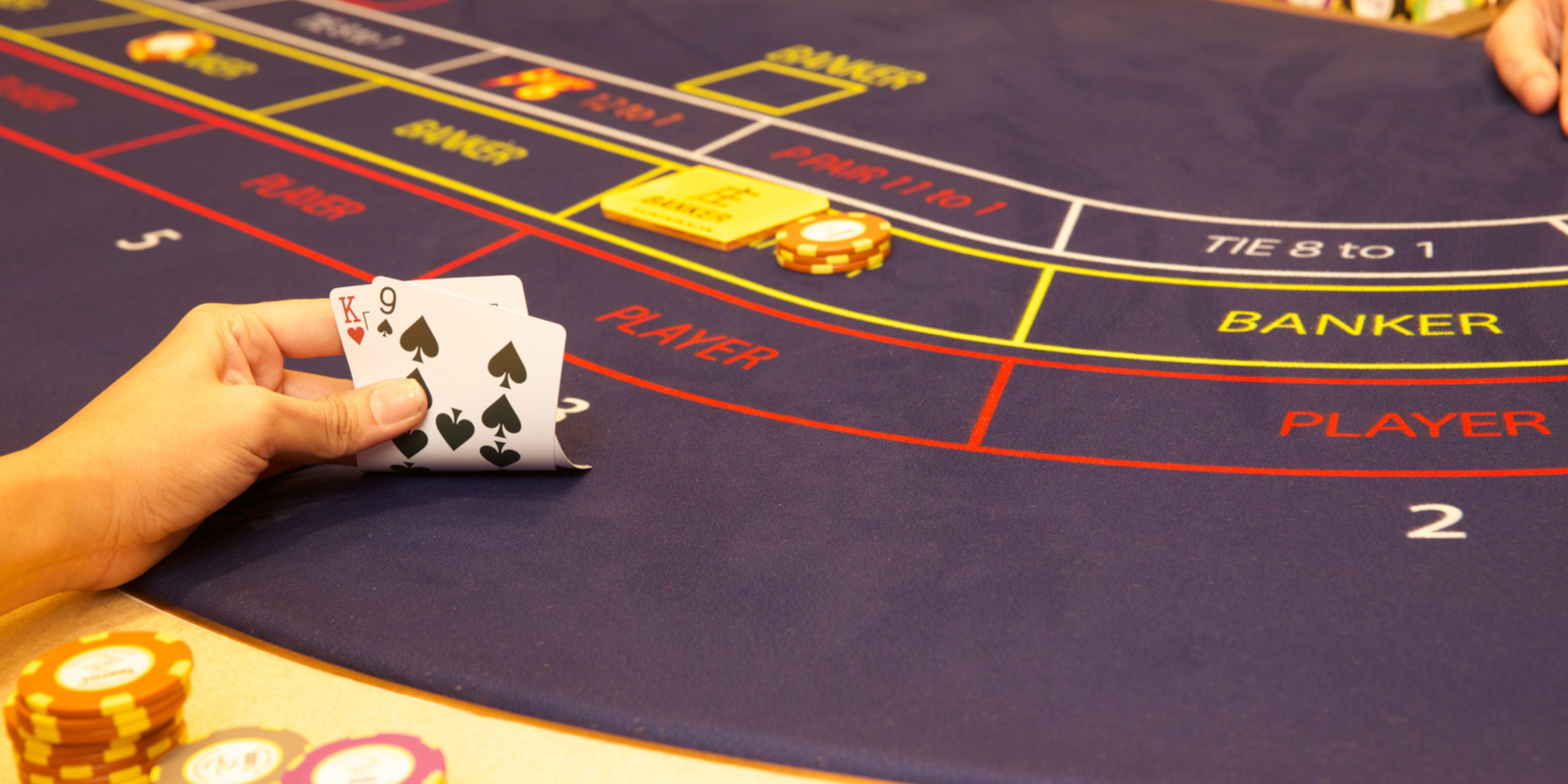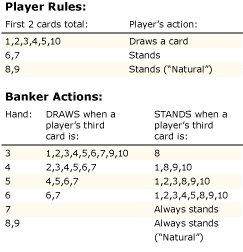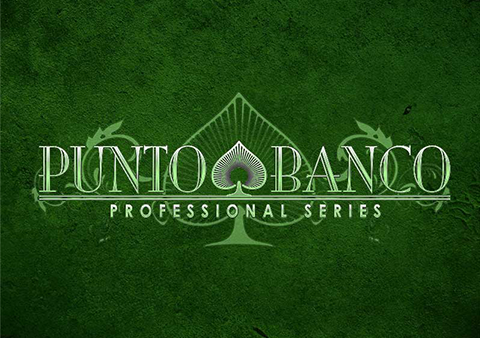- Punto Banco, a popular version of Baccarat in many Latin countries and elsewhere, has proven to be a successful draw in any casino.
- Player and banker third card dealing rules in the game of baccarat - we provide a clear English explanation accompanied by a third-card baccarat visual table.
The rules and objectives of Baccarat - the bets (player, banker and tie) and the third card rule. One of the basic card games that every gambler should know how to play!
Baccarat rules:Graphic courtesy MGM Grand, AU
The basics and how to play baccarat
Baccarat or Punto Banco is usually played in a separate casino area. The playing table is about the size of a craps table with three casino dealers and up to 12 or 14 players.
There are just two principal bets to make: banker or player - Banco or Punto, plus the rarely used Standoff. Some casinos let the players deal the cards in turn and others have a casino dealer to deal the cards. In online Baccarat the cards are dealt automatically by a virtual dealer.
Each player, including the player dealing, may bet on either Punto or Banco but it is customary for the dealer to bet on Banco. Players may opt not to deal, passing the 'Shoe' to the next player. The shoe remains with one player as long as the Bank wins. If Punto wins, the shoe passes on to the next player.
Two hands are dealt and you bet which one will win, or that they will tie. It is just like betting on Black or Red at roulette, and the payoff is even money, 1:1 (except for the standoff, which pays 8-1 or 9-1). The only difference between the Banco and Punto bet is a win on Banco will cost you 5% commission or tax levied by the casino - the in-built advantage.
Punto Banco Drawing Rules For Beginners
The reason for taxing the Banco is because it has been established that over an 8-deck cards play on average the Banco will win three to four hands more than the Punto.
Each hand consists of a minimum of two and a maximum of three cards. The person dealing will put two cards, face down, tucked under the shoe, and give the player with the largest bet on Punto the other two cards, face down.

The Punto player then looks at the cards and gives them back to the player who is dealing. Then the player who is dealing will turn over the cards of both hands while one of the casino dealers will announce the results and the winner.
If either hand has a total of 8 or 9 (nine is the highest), then it is called a 'Natural' and no more cards are dealt. If it is not a natural, then depending on the value of each hand the casino dealer may instruct the card dealer to deal a third card. The decision when to deal a third card follows precise set rules used by all casinos.
Once dealing is completed, the hand with the highest count wins. The paying casino dealers will collect the losing bets first and then pay the winning ones. The player who actually deals the cards is not responsible for the payouts. He is just like any other player, playing against the casino.
The rules
Baccarat is played from a six-deck or an eight-deck shoe. All face cards and 10s have no value. Cards less than 10 are counted at face value, Aces are worth 1. Suits don't matter. Only single digit values are valid. Any count that reaches a double digit drops the left digit. 15 is counted as 5 and 25 is also counted as 5.
To start, the players bet either on Banco or Punto or Standoff. The card dealer gives two cards each; first to the player and then the banker. The object of the game is to bet on the hand that you think will have the highest total value.
A third card may be dealt to either or both the player (Punto) and the bank (Banco) based on the following three-card-rules. It is not necessary to learn these rules to play, they are compulsory decisions and therefore automatic. Only on rare occasions a mistake is made:
Player's third-card-rule
- If either the player or the bank have a total of 8 or 9 on the first two cards no further cards are drawn. The resulting hand is called a natural and the hand is over.
- If the player's total is less than or equal to 5 the player's hand draws a third card.
- If the player does not draw a third card, then the bank's hand stands on 6 or more and takes a third card on a total of 5 or less. If the player does take a third card then the Bank's third-card-rule below will determine if the bank takes a third card.
Bank's third-card-rule
- If the bank's total is 2 or less then bank draws a card, regardless of what the players third card is.
- If the banks total is 3 then the bank draws a third card unless the players third card was an 8.
- If the banks total is 4 then the bank draws a third card unless the players third card was a 0, 1, 8, or 9.
- If the banks total is 5 then the bank draws a third card if the players third card was 4, 5, 6, or 7.
- If the banks total is 6 then the bank draws a third card if the players third card was a 6 or 7.
- If the banks total is 7 then the bank stands.
House advantage
Banker (Banco) 1.17%
Player (Punto) 1.36%
Tie (Standoff) 14.12% at 8:1 payout
See Chemin De Fer - A brief description of the French version of Baccarat.
Great gambling information site
Use the 'Main Menu' on the right margin to explore this site. This is a comprehensive great gambling information site with advice on winning, how to gamble, betting strategy, listing the best online casinos and world land-based casinos directory.
Topics covered include game summary, rules, how to play, how to win, game strategy, betting systems, gambling tips, on: Blackjack, Roulette, Poker classic and variants such as Texas Hold'em poker, Craps/Dice, Slots and Videopoker, Baccarat, Keno, Lottery, Powerball, Bingo, Sports betting, Horse racing and Greyhound racing.
This is the gambling website with lots of information and resources as well as helpful advice and frequent updates thanks to your helpful feedback.

Baccarat * Rules . Glossary . Tips . Strategy . Books . Links . Extras
Baccarat is called Punto Banco in many casinos in South America and Europe. 'Punto' means 'Player', while 'Banco' means 'Bank', in reference to the two principal bets of the game.
The object of the game is to bet on the hand (either 'Punto' or 'Banco') that you think will have a total of, or closest to, 9. Or to bet that both 'Punto' and 'Banco' hands will have the same total (a 'tie' or 'stand off').
Punto Banco is played at an oval table, similar to the French's 'Chemin de Fer' version. The actual number of players per table may vary from casino to casino.
The Punto Banco table is staffed by a croupier, who directs the play of the game, and two dealers who collect and pay bets as well as tallying commissions due.

Six or eight decks of cards are normally used, shuffled only by the croupier and dealers. Like 'Chemin de Fer', the shoe is passed around from player to player, who acts as the dealer of the cards and as 'banker,' but he or she does not actually bank the game. The 'banker' may bet on the player hand if he or she wishes, or may pass the shoe along to another player - the role of the 'banker' is merely ceremonial.

The player who has the highest bet on the 'Punto' hand is given the 'Punto' cards, though he or she simply turns the cards over, announcing their total. The croupier instructs the 'banker' when to deal third cards, and then announces the winning hand.
Punto Banco is usually played in special rooms separated from the main gaming floor, ostensibly to provide an extra measure of privacy and security because of the high stakes often involved.
Punto Banco games are frequented by high rollers, who may wager tens or hundreds of thousands of dollars on a single hand. Australian tycoon Kerry Packer is particularly fond of the game, having won and lost large sums over the years.
Minimum bets are relatively high, often starting at $25 and going as high as $500. Posted maximum bets are often arranged to suit a player, but maximums of $10,000 per hand are common.
Despite its simplicity (or perhaps because of it), Punto Banco offers the lowest house advantage among casino games. The 'Punto' bet has a house advantage of 1.24%, and the 'Banco' bet (despite the 5% commission) has an advantage of 1.06%. The 'Stand Off' bet has a much higher house advantage of 14.44%, based on six decks in play.
Because of its attraction for wealthy players, a casino may win or lose millions of dollars a night on the game.
Play Punto Banco Now!

The Punto player then looks at the cards and gives them back to the player who is dealing. Then the player who is dealing will turn over the cards of both hands while one of the casino dealers will announce the results and the winner.
If either hand has a total of 8 or 9 (nine is the highest), then it is called a 'Natural' and no more cards are dealt. If it is not a natural, then depending on the value of each hand the casino dealer may instruct the card dealer to deal a third card. The decision when to deal a third card follows precise set rules used by all casinos.
Once dealing is completed, the hand with the highest count wins. The paying casino dealers will collect the losing bets first and then pay the winning ones. The player who actually deals the cards is not responsible for the payouts. He is just like any other player, playing against the casino.
The rules
Baccarat is played from a six-deck or an eight-deck shoe. All face cards and 10s have no value. Cards less than 10 are counted at face value, Aces are worth 1. Suits don't matter. Only single digit values are valid. Any count that reaches a double digit drops the left digit. 15 is counted as 5 and 25 is also counted as 5.
To start, the players bet either on Banco or Punto or Standoff. The card dealer gives two cards each; first to the player and then the banker. The object of the game is to bet on the hand that you think will have the highest total value.
A third card may be dealt to either or both the player (Punto) and the bank (Banco) based on the following three-card-rules. It is not necessary to learn these rules to play, they are compulsory decisions and therefore automatic. Only on rare occasions a mistake is made:
Player's third-card-rule
- If either the player or the bank have a total of 8 or 9 on the first two cards no further cards are drawn. The resulting hand is called a natural and the hand is over.
- If the player's total is less than or equal to 5 the player's hand draws a third card.
- If the player does not draw a third card, then the bank's hand stands on 6 or more and takes a third card on a total of 5 or less. If the player does take a third card then the Bank's third-card-rule below will determine if the bank takes a third card.
Bank's third-card-rule
- If the bank's total is 2 or less then bank draws a card, regardless of what the players third card is.
- If the banks total is 3 then the bank draws a third card unless the players third card was an 8.
- If the banks total is 4 then the bank draws a third card unless the players third card was a 0, 1, 8, or 9.
- If the banks total is 5 then the bank draws a third card if the players third card was 4, 5, 6, or 7.
- If the banks total is 6 then the bank draws a third card if the players third card was a 6 or 7.
- If the banks total is 7 then the bank stands.
House advantage
Banker (Banco) 1.17%
Player (Punto) 1.36%
Tie (Standoff) 14.12% at 8:1 payout
See Chemin De Fer - A brief description of the French version of Baccarat.
Great gambling information site
Use the 'Main Menu' on the right margin to explore this site. This is a comprehensive great gambling information site with advice on winning, how to gamble, betting strategy, listing the best online casinos and world land-based casinos directory.
Topics covered include game summary, rules, how to play, how to win, game strategy, betting systems, gambling tips, on: Blackjack, Roulette, Poker classic and variants such as Texas Hold'em poker, Craps/Dice, Slots and Videopoker, Baccarat, Keno, Lottery, Powerball, Bingo, Sports betting, Horse racing and Greyhound racing.
This is the gambling website with lots of information and resources as well as helpful advice and frequent updates thanks to your helpful feedback.
Baccarat * Rules . Glossary . Tips . Strategy . Books . Links . Extras
Baccarat is called Punto Banco in many casinos in South America and Europe. 'Punto' means 'Player', while 'Banco' means 'Bank', in reference to the two principal bets of the game.
The object of the game is to bet on the hand (either 'Punto' or 'Banco') that you think will have a total of, or closest to, 9. Or to bet that both 'Punto' and 'Banco' hands will have the same total (a 'tie' or 'stand off').
Punto Banco is played at an oval table, similar to the French's 'Chemin de Fer' version. The actual number of players per table may vary from casino to casino.
The Punto Banco table is staffed by a croupier, who directs the play of the game, and two dealers who collect and pay bets as well as tallying commissions due.
Six or eight decks of cards are normally used, shuffled only by the croupier and dealers. Like 'Chemin de Fer', the shoe is passed around from player to player, who acts as the dealer of the cards and as 'banker,' but he or she does not actually bank the game. The 'banker' may bet on the player hand if he or she wishes, or may pass the shoe along to another player - the role of the 'banker' is merely ceremonial.
The player who has the highest bet on the 'Punto' hand is given the 'Punto' cards, though he or she simply turns the cards over, announcing their total. The croupier instructs the 'banker' when to deal third cards, and then announces the winning hand.
Punto Banco is usually played in special rooms separated from the main gaming floor, ostensibly to provide an extra measure of privacy and security because of the high stakes often involved.
Punto Banco games are frequented by high rollers, who may wager tens or hundreds of thousands of dollars on a single hand. Australian tycoon Kerry Packer is particularly fond of the game, having won and lost large sums over the years.
Minimum bets are relatively high, often starting at $25 and going as high as $500. Posted maximum bets are often arranged to suit a player, but maximums of $10,000 per hand are common.
Despite its simplicity (or perhaps because of it), Punto Banco offers the lowest house advantage among casino games. The 'Punto' bet has a house advantage of 1.24%, and the 'Banco' bet (despite the 5% commission) has an advantage of 1.06%. The 'Stand Off' bet has a much higher house advantage of 14.44%, based on six decks in play.
Because of its attraction for wealthy players, a casino may win or lose millions of dollars a night on the game.
Play Punto Banco Now!
Punto Banco General Rules
Punto Banco Drawing Rules How To Play
No hand receives more than three cards
When 'Punto' and 'Banco' hands are equal, a 'Stand-Off' is declared
Tens and face cards (all jacks, queens and kings) are worth zero, aces are worth one, and all other cards are worth their face value
If the value of a hand exceeds nine, the value is adjusted by subtracting 10 from the total
- Example:
| HAND | ACTUAL VALUE |
|---|---|
| + = 15 | 5 |
| + + = 18 | 8 |
| + = 19 | 9 |
| + = 18 | 8 |
Punto Banco Drawing Rules For Dummies
Play Punto Banco Now!

